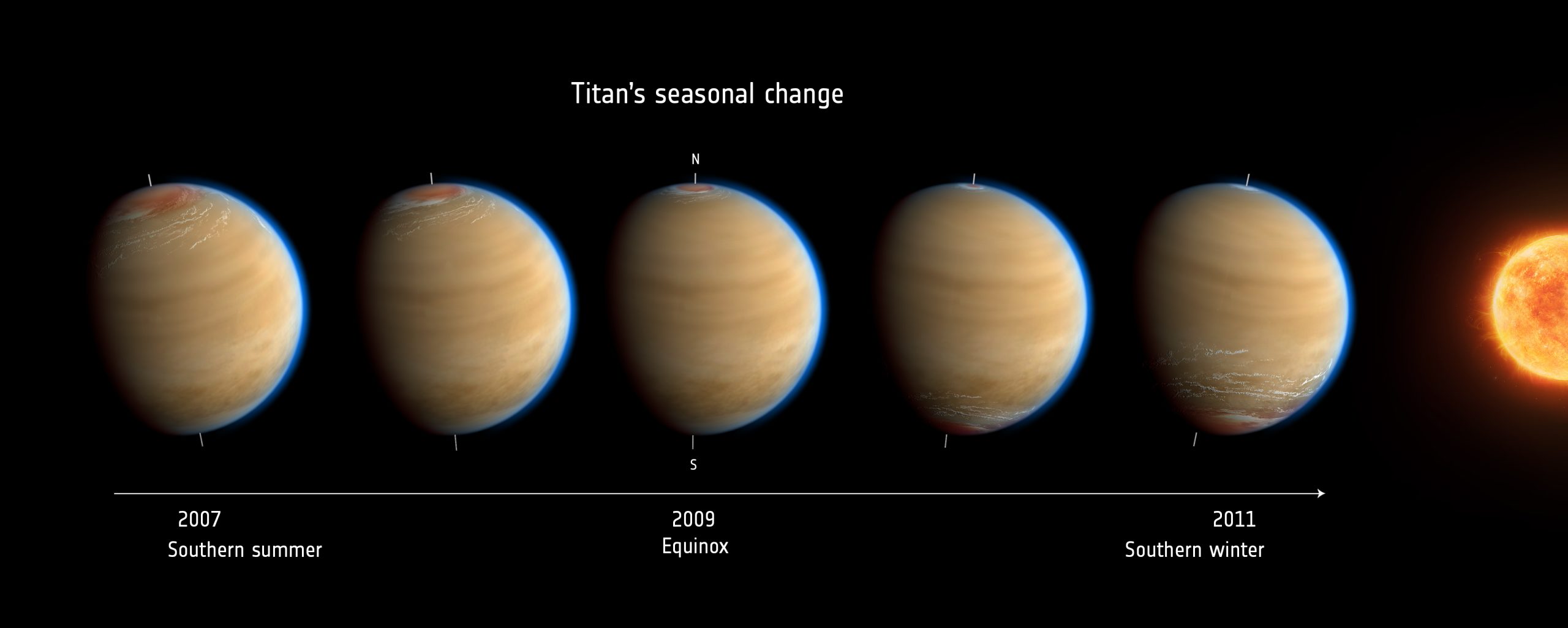{multithumb thumb_width=300}
As we are getting ready for the winter in the northern hemisphere, seasonal changes on Saturn’s biggest moon are also starting to be rapidly noticed. An international team of scientists has observed the most dramatic increase in concentrations of trace gases since the Cassini satellite arrived at Saturn in 2004. These changes are probably related to the reversal of the vertical air circulation on Titan. The results of the research, which could lead to a better understanding of planetary atmospheres, will be published in Nature.

Just like the Earth, Titan has a dense nitrogen atmosphere but because this moon is much further from the sun it is quite a bit colder. Seasons also occur on Titan because its rotational axis is oblique with respect to the sun. Consequently one pole is exposed to continuous sunlight for a period of half a Saturn year, whereas the other pole remains in darkness. Due to its longer orbit around the sun a year on Titan takes 29.5 earth years, which means that Titan’s North Pole was in darkness from 1995 to 2009. Since then the South Pole has cooled down and now it is autumn in the southern hemisphere. It was expected that with this change of season, Titan’s atmosphere would also change.
“Titan’s dark pole is never visible from earth because it is always pointing away from us due to the geometry of the orbit. The Cassini space craft therefore offers us a unique opportunity to observe the change in season,” says Nick Teanby from the University of Bristol, the first author of the article. ” Changes are particularly interesting at the poles of Titan, because there they are the greatest.”
Trace gases
With Cassini’s Composite Infrared Spectrometer the scientists observed an enormous increase of a number of exotic trace gases above the South Pole within a relatively short space of time. These trace gases are formed high up in Titan’s atmosphere, where sunlight and high-energy particles break down the most important gases, methane and nitrogen. Remco de Kok, researcher at SRON Netherlands Institute for Space Research and co-author of the article: “We were waiting for signs that the trace gases would change with the season, but we had not expected such large and rapid changes: some gas concentrations increased more than 1000 times within a period of several months. It was also surprising that this happened at an altitude of more than 450 km, far higher than originally thought.”
The changes in gas concentrations are probably related to the inversion of the vertical air circulation on Titan. Just before 2009 the air was still circulating upwards at the South Pole and subsequently moved northwards to descend again at the North Pole. However that appears to be changing. Teanby: “Titan’s middle atmosphere consists of the stratosphere and the mesosphere, 100-500 km high above the moon’s surface. This part of the atmosphere orbits around Titan far quicker than the surface revolves. Horizontal wind speeds of up to 200m/s (720 km per hour) can occur. Vertical winds are far slower, just a few millimeters per second, and are difficult to measure. We used Cassini’s measurements of the temperature and chemical composition of the atmosphere to observe the subtle vertical wind and the airflow from pole to pole. For the first time we have now observed an inversion around the spring point of 2009. The resulting distribution of the gases indicates that this airflow reaches far higher than was thought, up to 600 km or even higher. We cannot observe the atmosphere at an altitude of 600 km, but we could derive this information from the moment at which the trace gas concentrations started to increase.”
“Our results have yielded important improvement points for atmospheric models of Titan. Titan is functioning here as a natural laboratory of how a rocky planet behaves in the cold outer part of the solar system. These results could therefore eventually lead to a more complete understanding of processes in the atmosphere of earth and of other planets in the solar system as well as the many exoplanets (planets orbiting a star other than our sun) that are currently being discovered.”
Publication
The research team consists of Nicholas A. Teanby (University of Bristol), Patrick G. J. Irwin en Simon B. Calcutt (University of Oxford), Conor A. Nixon en F. Michael Flasar (NASA Goddard Space Flight Center), Remco de Kok (SRON Netherlands Institute for Space Research), Sandrine Vinatier en Athena Coustenis (CNRS), Elliot Sefton-Nash (University of California, University of Bristol). The research results have been published today in Nature: Active upper-atmosphere chemistry and dynamics from polar circulation reversal on Titan.


